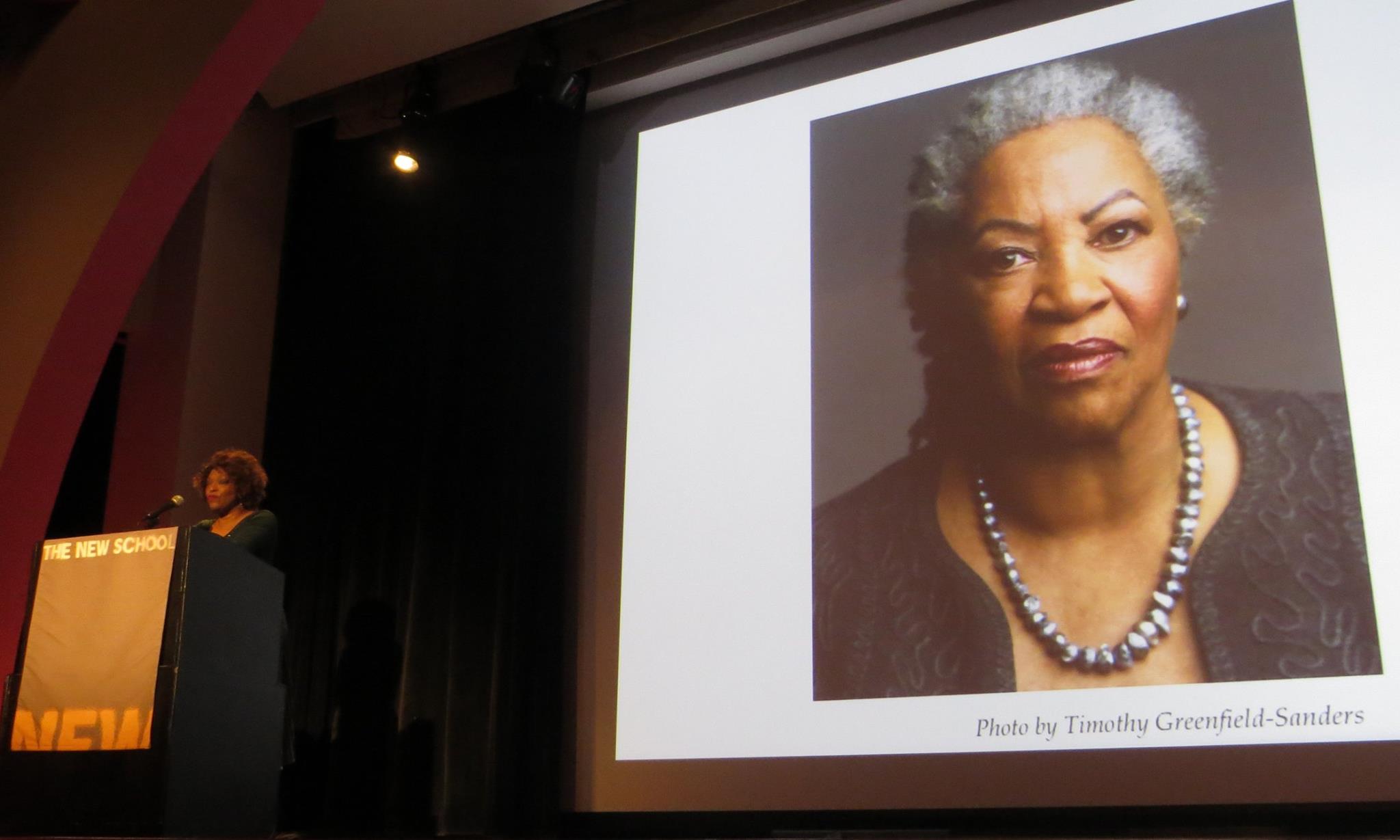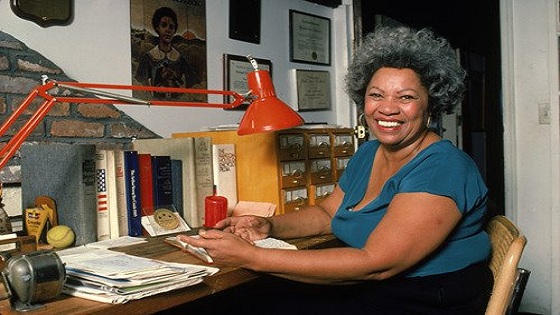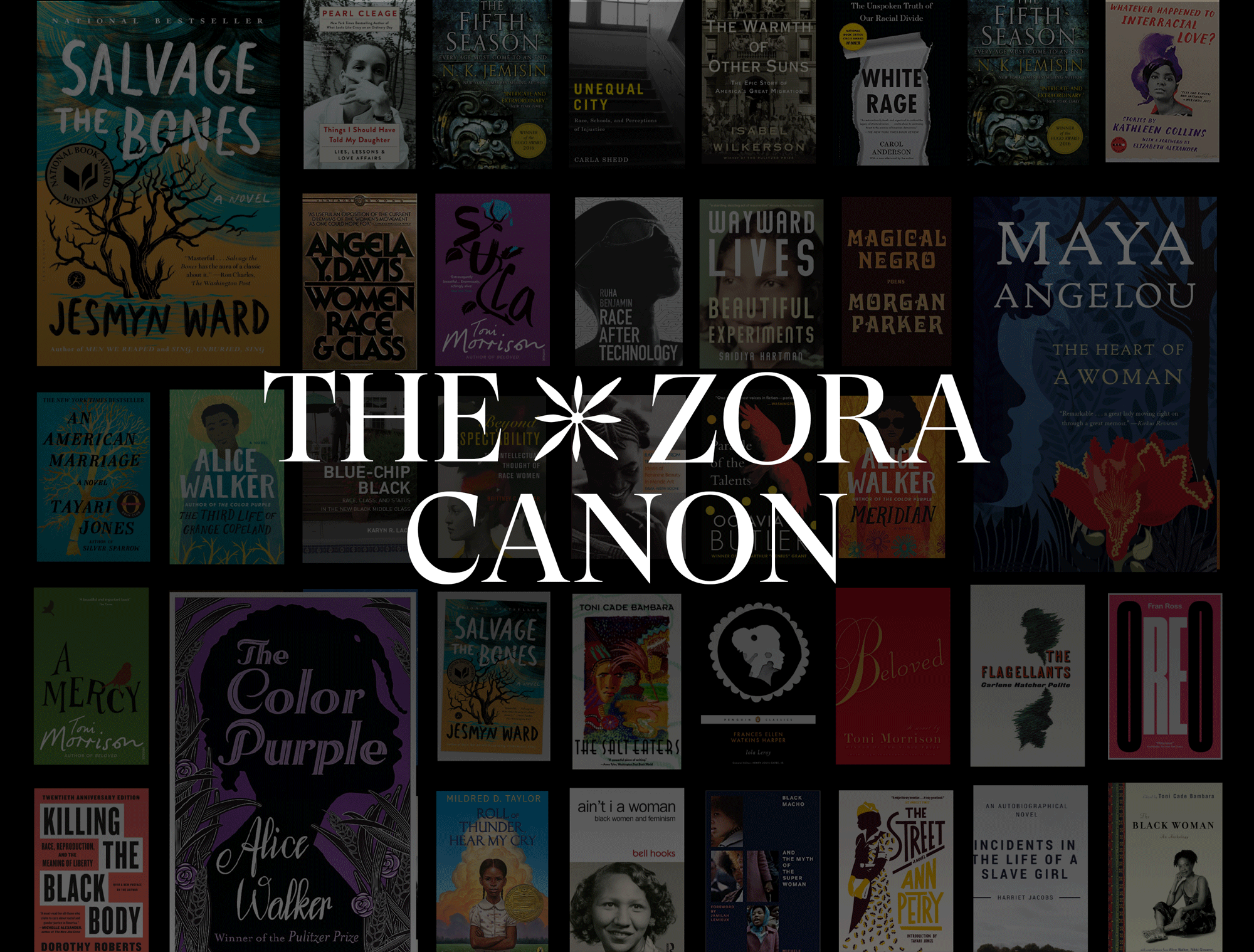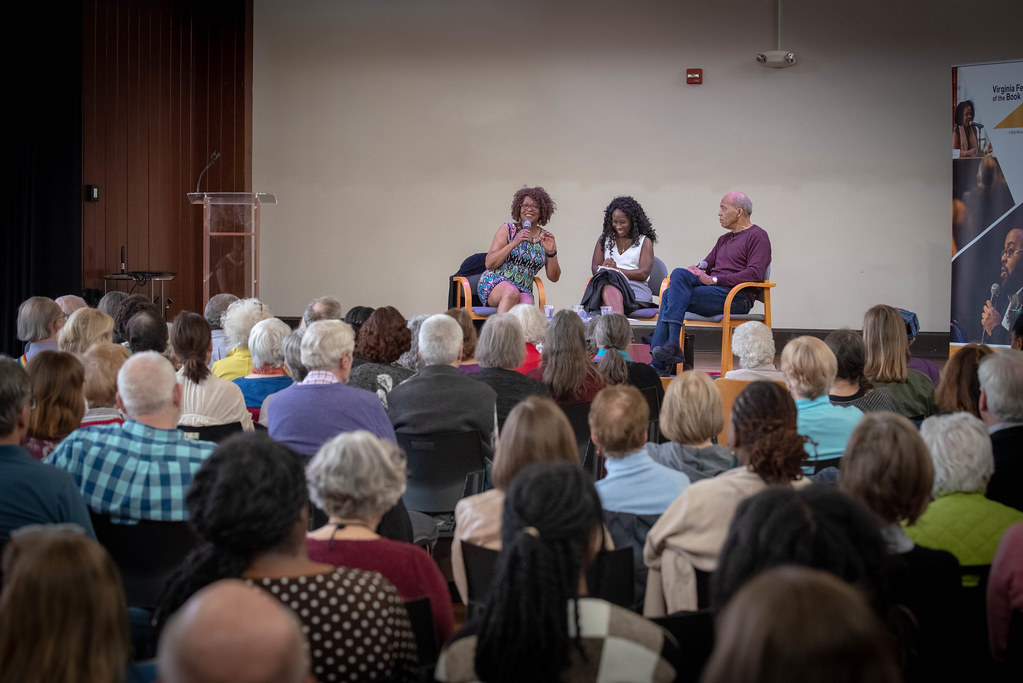
Poet Rita Dove introduced Toni Morrison—the only living American Nobel recipient in literature—with joy and grace and poetry at the New School in Manhattan, where Morrison received the National Book Critics Circle’s Ivan Sandrof award—its lifetime achievement prize. The NBCC stressed that Morrison the editor, the essayist, the critic, the mentor and professor had made enormous contributions to American letters, in addition to her luminous books. But it was the eloquent Dove, a Pulitzer winner, a former U.S. poet laureate and long-serving juror of the Anisfield-Wolf Book Awards, who made a case for the ages. Dove remembered herself as a searching young woman, the only African American graduate student at the University of Iowa’s Writer’s Workshop:
“One day, deep in the bowels of the library, I stopped dead in my tracks. Something had caught my eye; I wasn’t sure what. There, just behind my left shoulder . . . I couldn’t shake the feeling a book was looking for me. Since it was spring, when such things happen, I didn’t question the feeling, I just turned around. And there it was, at eye-level, bound in black linen and peacock-blue lettering: THE BLUEST EYE by Toni Morrison.”
This first novel, which transformed Dove, met a different initial critical reception, one Morrison remembered as “slight, indifferent, even hostile” until the critic John Leonard took up the novel and wrote about it.
Last Thursday night, when a resplendent Morrison, 84, rolled onto the stage in her wheelchair and wearing a gray beret, a standing ovation enveloped her. She looked at Dove, smiled and cracked wise: “Rita, that was beautiful. And true.”
Read the entire Dove introduction, reprinted with permission, here:
Good evening. Thank you, Steven Kellman and the Board of the National Book Critics Circle, for inviting me to introduce Toni Morrison as the recipient of this year’s Ivan Sandrof Lifetime Achievement Award. Although Toni Morrison certainly doesn’t need an introduction per se, there can scarcely be too many celebratory tributes to one of the greatest novelists of our time and the only living American Nobel laureate in literature. I don’t have to rattle off Toni Morrison’s many accomplishments and honors to those present here tonight. As book critics you are, by and large, deeply familiar with her works, and your organization was among the very first to publicly recognize the rising star when, in 1977, she received the National Book Critics Circle Award for “Song of Solomon.”
In our age of factual information cascading from smart phones at the tap of a few buttons, you don’t need me to refresh your memory with all the titles of our honoree’s eleven luminous – and illuminating – novels and her numerous other works – the plays and essays and children’s books. I also assume you wouldn’t want me to whittle away minutes at this podium with a recitation of previous awards… although, I admit, it is tempting to mention at least a few – such as the 1988 Pulitzer Prize for “Beloved,” the 1996 Jefferson Lecture, the National Humanities Medal in 2000, the honorary doctorate from Oxford and the 2012 Presidential Medal of Freedom.
Although my personal panoply of greats—that literary Valhalla I call upon for inspiration—is heavily weighted in favor of the craft of poetry, Toni Morrison has always commanded a prime seat front and center, for she is not only a prose virtuoso but also a master of poetic sensibilities and lyrical language: Her influence on discourse, idiom and the vernacular has transformed our perception of the intricate paths to the interior consciousness – be it the thoughts of an illiterate slave or the harrowing logic fabricated by a father guilty of incest; of children whose souls have been damaged beyond the reach of pity and women ravaged by a longing so desperate that nothing short of annihilation will satisfy; of a ghost starved for love, of a town bent on its own brand of self-preservation. With an extraordinary poet’s economy of idiom and her signature elliptical elegance, Toni Morrison has probed the crannies and tunnels of mental illness and the torment of war veterans shattered by the myriad possibilities for sabotage in the world; she has recreated the improvisational call-and-response of jazz, the see-saw proclivities of obsessive attraction and violence freighted with fear. And while birthing upon the literary stage a host of characters we, the readers, recognize as familiar and accept in the way of Family, from the praiseworthy to the quirky to the closeted, she has also been – subtly, cannily – at work on fashioning a new graph of American history whose many intersecting trajectories take us from the Anglo-Dutch slave trade through the ante-bellum insanities of Southern racial terror, from the Great Migration and 1920’s Harlem to the labor pains of the Automobile Age whose factories disgorged a glittering stream of chrome-trimmed fantasies from what are now the rust belt cities of the Midwest; from the L.A. cosmetics industry to a trailer parked outside of Whiskey, California.
A few days after I received Steven Kellman’s call asking me if I’d like to pay homage to Toni Morrison tonight – an undertaking somewhat tantamount to introducing Athena, while she looks on with her gray eyes – my husband and I went to a dance – a milonga – at our local Argentine tango club. In an attempt to boost everyone’s mood in the middle of a drear, chilly winter and as a nod to the Carneval season, everyone was asked to come masked. But when we arrived with our Venetian facial wear and harlequin confections, we quickly discovered that the masks got in the way of dancing – ribbons tangled, feathers snagged on gold braid trim, and with obstructed peripheral vision, balance was impaired so we teetered and wobbled. After a quick confab with the young man who had asked me for the second set of tangos – a newcomer to our town – we decided to ditch the masks; and as the bandoneon throbbed to Carlos Gardel singing about the kind of woman who can ignite an “instant violent love”, my dance partner remarked, out of the blue: “Now that’s some Toni Morrison love.” I was struck with speechless. But by the next day my curiosity had overwhelmed my hesitancy, so I asked this young man, via a Facebook message, what his first encounter with the books of Toni Morrison had been. His response was effusive and – there’s no other way to describe it – grateful. He wrote:
I think I was 22 or 23—after college but before grad school. I went into a bookstore and had a sort of literary crisis. I felt that so many of the authors on the shelves were creating entire worlds and entire castes of characters that merely served as backdrops for the breakdown of yet another petty “I.” Like all those books could be retitled “The Day *I* Was Sad.” Then I picked up “Beloved.” Faith in literature restored. What a genius Morrison is! I think so many novelists are like peacocks with their language, flourishing feathers and letting the reader know how smart and lyrical they are. But I think Morrison is able to do extreme lyric and yet be conversational at the same time. I wish I had found her work earlier. I want to know why she isn’t required reading in school. Morrison has wisdom in abundance, along with lyrical and storytelling brilliance. I wonder how she does it.
And my tango-dancing friend ended with a postscriptum prompted by his wife of just a few months:
Now my wife wants to tell you about how she battled the Dominican obsession with Aryan features as a teenager but then encountered “The Bluest Eye” in high school. She says Morrison gave voice to all of her dissent and made her comfortable with it.
Four decades earlier I had fought a similar battle with myself and the strange environment I had chosen to immerse myself in when I attended the University of Iowa’s Writers Workshop as its only African-American graduate student. As a young poet still trying to locate myself in the thicket of literary traditions, I often wandered the stacks, willing myself into unknown territory. I had yet to find myself, or at least an image I could identify with, in the pages of European and American literature; while most of the books concerned with Black America took place, by and large, either in the Deep South or in urban ghettos. What about the experiences and dreams of a black girl growing up middle class in middle America? I wondered. Was there no room, no mirror, for me? Then one day, deep in the bowels of the library, I stopped dead in my tracks. Something had caught my eye; I wasn’t sure what. There, just behind my left shoulder . . . I couldn’t shake the feeling that a book was looking for me. Since it was spring, when such things happen, I didn’t question the feeling; I simply turned around. And there it was, at eye-level, bound in black linen with peacock-blue lettering: THE BLUEST EYE, by Toni Morrison.
The library had removed all book jackets, so there was no biographical note, no blurb to give me a hint of the contents. The title intrigued me; I didn’t know the author, but as soon as I opened the book and began to read, I was convinced that Toni Morrison, whoever she was, knew me, my people and where I came from – Akron, Ohio, one of the industrial towns sprinkled along the smudged neckline of the Great Lakes. By the time I finished the opening section – those three amazing paragraphs mimicking the eerie deadpan of primary school primers, variations on an American Dream gone horribly wrong – I was certain that this writer had also experienced, as I had, the “double-consciousness” which W.E.B. Du Bois defines as that “peculiar sensation … of always looking at one’s self through the eyes of others, of measuring one’s soul by the tape of a world that looks on in amused contempt and pity.” When I reached the sentence, “Not even the gardens fronting the lake showed marigolds that year,” a wild hope began to stir that maybe, just maybe, she was from the Midwest. Fifteen pages later came the confirmation I craved: “There is an abandoned store on the southeast corner of Broadway and Thirty-fifth Street in Lorain, Ohio.” I began to shiver. My gut response had been right: Toni Morrison was a home girl.
No words can fully express what Toni Morrison has meant to me ever since – as a writer, a woman, a black woman, and, yes, a fellow Ohioan. She gave me literary shelter and pointed me toward the poetry in my geographical space. She taught me to pay attention to everything without prejudice, for beauty can be found in the “ginger sugar” smell rising from a polluted lake, and the fate of an empire can rest on the curve of an eyebrow. Her work has accompanied me through my years of honing myself as a writer and a woman. How desolate that journey would have been without Milkman and First Corinthians, or Flores or the intrepid Sula; without Toni’s wry humor and chastening gaze, her laughter that seems to come straight up from the middle of the earth!
Over the years Toni and I have met a number of times – official events as well as more private gatherings; even once by chance, late one evening in a hotel lobby in Cleveland where we convinced the bartender to serve one more round of drinks before closing shop. But two scenes with Toni stand out vividly – a 1994 tribute in her honor at the Cathedral of St. John the Divine, and a gala seven years later at the New York Public Library in celebration of her 70th birthday. In both places Toni was surrounded by orchids. Orchids – those gorgeous, engorged blooms that come in every color you can think up (and beyond), their petals veined like human hands held to the light, with a smell as intimate and ravishing as an indelicate thought crossing your mind in the middle of the 23rd psalm. As symbols of love and desire (both the light and the dark sides), they can make young girls blush and coax a Mona Lisa smile from a grown woman; these curiously mammalian creatures that seem to live on nothing but mist and air, yet can inspire in their breeders a devotion teetering on madness. Orchids are the queen bees of the flower world, and you better not mess with them.
Like the orchids surrounding her then, Toni Morrison has always seemed both rooted in the earth and poised for flight, resplendent and serene. Most importantly, she has woven tales that beguile, even as they lead us deeper into the carefully shielded psyche of homo sapiens than we knew to go. She has given us stories where survival may not mean victory and cruelty may reveal itself as the ultimate tenderness; stories where home is not a country, especially when the country has never learned to be at home with its past – and from the midst of those magnificent specimens of art, Toni Morrison – woman, mother, editor, writer, critic, Nobel laureate, professor, mentor, friend – shines all the more fiercely. I thank you, Toni, for your life’s work past, present and future, and for your resplendent example. May you keep on shining.



